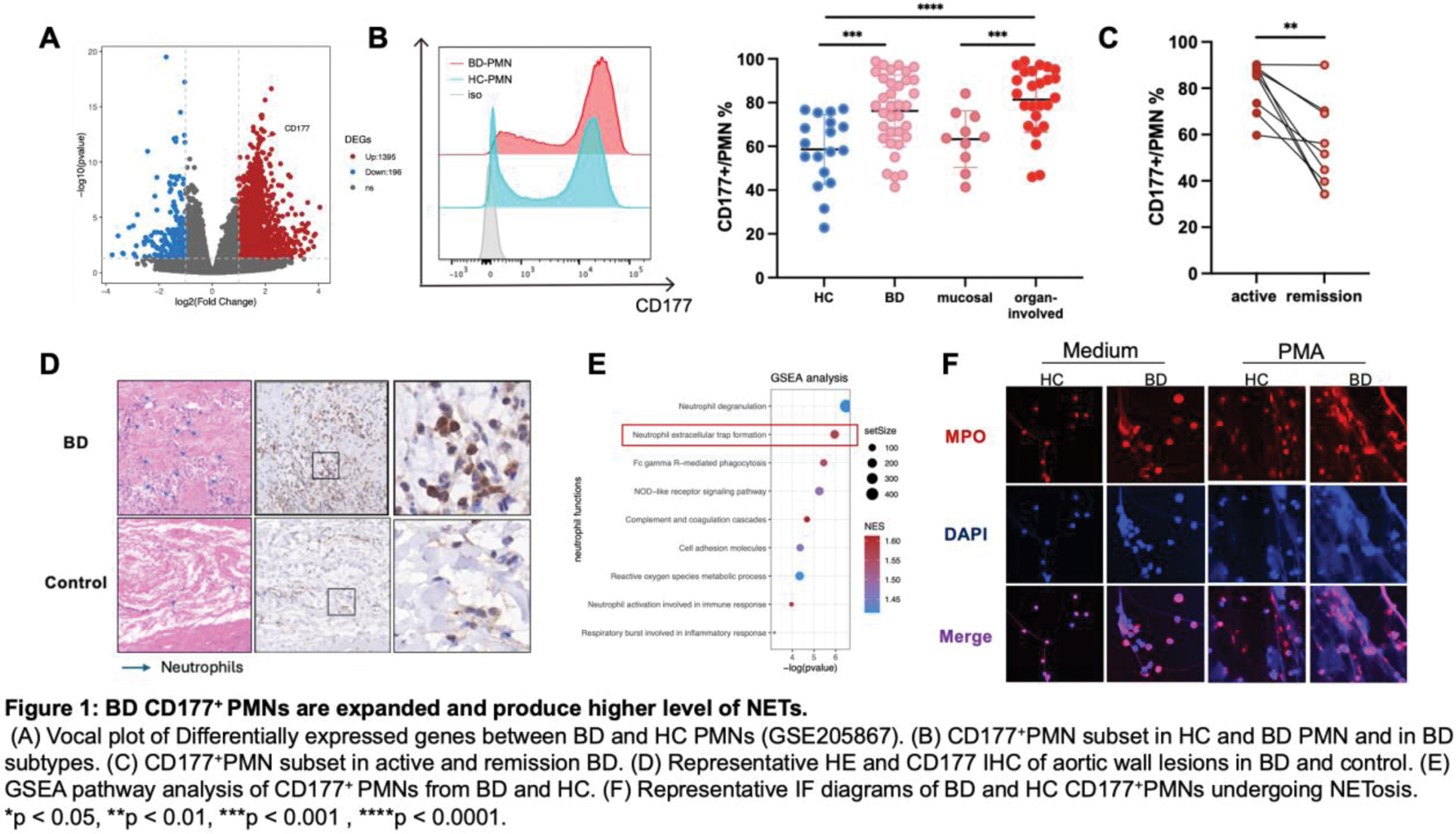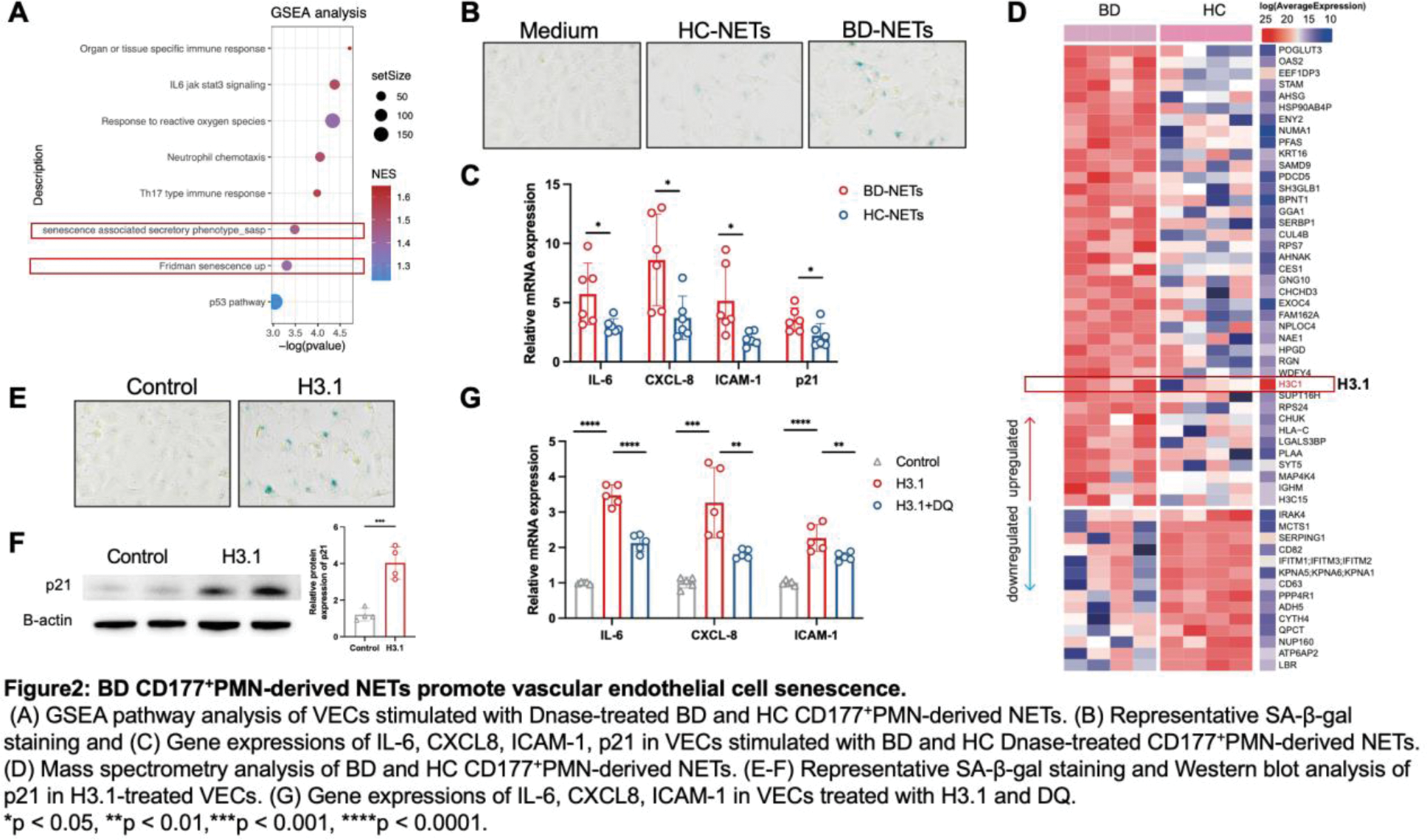

Background: Behçet’s disease (BD) is a chronic systemic vasculitis characterized by polymorphonuclear neutrophil (PMN) activation and subsequent endothelial dysfunction. However, the pathogenic role of PMNs on endothelial cells in BD remains largely unknown.
Objectives: To investigate the role of CD177 + PMN on endothelial cells in BD.
Methods: Our previously published RNAseq data of BD and healthy controls (HC) PMNs (GSE205867) were re-analyzed [1]. CD177 + PMNs were quantified by flow cytometry in an independent BD and HC cohort. CD177 expression in BD aortic lesions were examined using immunohistochemistry. RNAseq analysis of BD and HC CD177 + PMNs were performed. Neutrophil extracellular traps (NETs) produced by BD and HC CD177 + PMNs were quantified by IF, and were used to stimulate vascular endothelial cells (VECs), which were subjected to RNAseq analysis. Senescence and Senescence-associated secretory phenotype (SASP) of VECs were validated using SA-β-gal staining, qRT-PCR and Western blot [2]. Differentially expressed proteins in NETs produced by BD and HC CD177 + PMNs were determined by Mass spectrometry, and were used to induce senescence and SASP of VECs, which were treated with dasatinib and quercetin (DQ).
Results: Transcriptome analysis suggested BD-PMN overexpressed CD177 (Figure 1A). CD177 + PMN subset was expanded in BD, especially in patients with organ involvement (Figure 1B), which was decreased after remission (Figure 1C). Moreover, CD177 + PMNs were accumulated in aortic walls of BD (Figure 1D). GESA analysis indicated enhanced NETosis in BD CD177 + PMNs (Figure 1E), which was confirmed in both resting and activated BD CD177 + PMNs (Figure 1F). GESA analysis revealed BD CD177 + PMN-derived NETs promoted senescence and SASP in VECs (Figure 2A), which were validated by upregulated SA-β-gal and IL-6, CXCL8, ICAM-1, p21 (Figure 2B-C), not abrogating by DNase. Mass spectrometry identified BD CD177+ PMN-derived NETs contained more Histone 3.1 (H3.1) (Figure 2D), which induced senescence and SASP in VECs (Figure 2E-F). Senolytics attenuated H3.1-elicited SASP by VECs (Figure 2G).
Conclusion: Increased CD177 + PMN in BD patients promoted senescence and senescence-associated secretory phenotype in vascular endothelial cells through secreting NETs enriched with H3.1, which potentially contributed to vascular damage in BD.
REFERENCES: [1] Yu, Xin et al. “Transcriptional analysis of neutrophils from patients with Behçet’s disease reveals activation and chemotaxis of neutrophils.” Clinical immunology (Orlando, Fla.) vol. 245 (2022): 109161. doi:10.1016/j.clim.2022.109161.
[2] Ogrodnik, Mikolaj et al. “Guidelines for minimal information on cellular senescence experimentation in vivo.” Cell vol. 187,16 (2024): 4150-4175. doi:10.1016/j.cell.2024.05.059.


Acknowledgements: We thank the health professional staff from the Department of Rheumatology and Clinical Immunology, Peking Union Medical College Hospital and appreciate the participation of all the patients in this study.
Disclosure of Interests: None declared.
© The Authors 2025. This abstract is an open access article published in Annals of Rheumatic Diseases under the CC BY-NC-ND license (